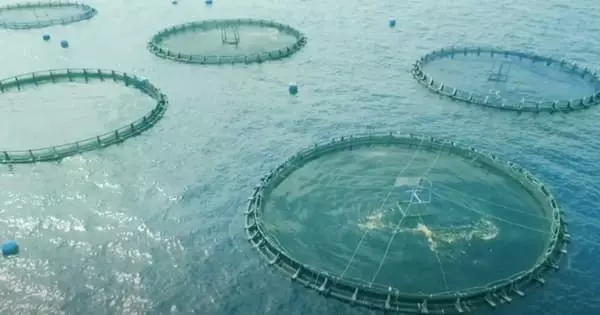Methane, a potent greenhouse gas, can be captured and converted into protein-rich feed for farmed fish, a growing food sector. A new study shows how to make the approach less expensive than current fish feeds.
An innovative process for converting a potent greenhouse gas into a food security solution has been stalled by economic uncertainty, much like a mirage on the horizon. A first-of-its-kind Stanford University study now assesses the market potential of the approach, which involves feeding bacteria-fed captured methane to grow protein-rich fishmeal. The study, published on November 22 in Nature Sustainability, discovered that production costs involving methane captured from specific sources in the United States are lower than the market price for conventional fishmeal. It also identifies cost-cutting measures that could make the approach profitable when using other methane sources and capable of meeting all global fishmeal demand.
“Industrial sources in the United States emit a truly staggering amount of methane, which is uneconomical to capture and use with current applications,” said study lead author Sahar El Abbadi, a graduate student in civil and environmental engineering who conducted the research.
Our goal is to flip that paradigm by using biotechnology to create a high-value product. While some companies are already doing this with pipeline natural gas as feedstock, methane emitted at large landfills, wastewater treatment plants, and oil and gas facilities would be a preferable feedstock.
El Abbadi
“Our goal is to flip that paradigm by using biotechnology to create a high-value product,” said El Abbadi, who is now a lecturer in Stanford’s Civic, Liberal, and Global Education program.
Two problems, one solution
Although carbon dioxide is more abundant in the atmosphere, methane has a global warming potential that is approximately 85 times that of carbon dioxide over a 20-year period and at least 25 times that of carbon dioxide a century after its release. Methane also endangers air quality by increasing the concentration of tropospheric ozone, which is responsible for an estimated 1 million premature deaths worldwide due to respiratory illnesses each year. Since the beginning of the Industrial Revolution, the relative concentration of methane has increased more than twice as fast as that of carbon dioxide, owing largely to human-caused emissions.
Methanotrophs, which consume methane, may hold the key to finding a solution. These bacteria can be grown in a chilled, water-filled bioreactor that receives pressurized methane, oxygen, and nutrients like nitrogen, phosphorus, and trace metals. The resulting protein-rich biomass can be used as fishmeal in aquaculture feed, reducing demand for fishmeal made from small fish or plant-based feeds that require land, water, and fertilizer.

“While some companies are already doing this with pipeline natural gas as feedstock, methane emitted at large landfills, wastewater treatment plants, and oil and gas facilities would be a preferable feedstock,” said study co-author Craig Criddle, a professor of civil and environmental engineering in Stanford’s School of Engineering. “This would have a number of advantages. Lower levels of potent greenhouse gas in the atmosphere, more stable ecosystems, and positive financial outcomes are among the benefits.”
Seafood consumption, an important global source of protein and micronutrients, has more than quadrupled since 1960. As a result, wild fish stocks have been severely depleted, and fish farms now provide roughly half of all animal-sourced seafood we consume. According to a comprehensive review of the sector led by researchers at Stanford and other institutions, global demand for aquatic animals, plants, and algae will likely double by 2050.
While methane-fed methanotrophs can provide feed for farmed fish, the economics of the approach remain unknown, despite the fact that prices for conventional fishmeal have nearly tripled in real terms since 2000. The Stanford researchers modeled scenarios in which methane is sourced from relatively large wastewater treatment plants, landfills, and oil and gas facilities, as well as natural gas purchased from the commercial natural gas grid, to clarify the approach’s potential to meet demand profitably. Their research looked at a variety of factors, such as the cost of electricity and labor availability.
Toward turning a profit
The analysis discovered that methanotrophic fishmeal production costs were lower in scenarios involving methane captured from landfills and oil and gas facilities, at $1,546 and $1,531 per ton, respectively, than the 10-year average market price of $1,600. The production costs for the scenario in which methane was captured from wastewater treatment plants were slightly higher $1,645 per ton than the average market price of fishmeal. Because of the cost of purchasing natural gas, the scenario in which methane was purchased from the commercial grid resulted in the most expensive fishmeal production costs $1,783 per ton.
Electricity was the most expensive expense in every scenario, accounting for more than 45 percent of total cost on average. Production costs fell by more than 20% in states with low electricity prices, such as Mississippi and Texas, making it possible to produce fishmeal from methane for $1,214 per ton, or $386 less per ton than conventional fishmeal production. Electricity costs could be reduced even further, according to the researchers, by designing reactors that transfer heat more efficiently, requiring less cooling, and switching electric-powered applications to those powered by stranded gas that would otherwise be wasted or unused, which can also reduce reliance on grid electricity for remote locations. In scenarios involving methane from wastewater treatment plants, the wastewater could be used to provide nitrogen, phosphorus, and cooling.
According to the study, if efficiencies like these could reduce the production cost of a methanotroph-based fishmeal by 20%, the process could profitably supply total global demand for fishmeal with methane captured in the United States alone. Similarly, if costs are reduced further, the process could replace soybeans and animal feeds.
“Despite decades of effort, the energy industry has had difficulty finding a good use for stranded natural gas,” study co-author Evan David Sherwin, a postdoctoral researcher in energy resources engineering at Stanford, said. “Once we began looking at the energy and food systems in tandem, it became clear that we could solve at least two long-standing problems at the same time.”





